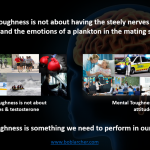Mental Toughness – misconceptions

There is still a misconception that Mental Toughness is all about biceps, triceps & testosterone and that doing one-finger press-ups, running up hills with a backpack and swimming across icy lakes will help you to develop it.
In fact, it’s quite possibly the reverse, it’s your Mental Toughness that would enable you to run up those hills and swim across those lakes.
Disguised under other terms, the notion of Mental Toughness has been around since, at least, the end of the 19th century; Accomplishment, Need for achievement, Hardiness, Resilience and, more recently, Grit and Mindset all have their roots in Mental Toughness.
Going back even further in time, the Stoics talked, unknowingly, about Mental Toughness with their notion of fortitude – “having emotional power and the ability to withstand adversity”
Sports coaches have been referring to Mental Toughness for many years now and whenever Nadal, Federer or Djokovic come back from two sets down to win a grand slam; their Mental Toughness is evoked – and clearly, all three have undoubtedly high Mental Toughness.
One of the earliest definitions of Mental Toughness was put forward by Jim Loehr, a leading sports psychologist; he defined it as, “The ability to consistently perform towards the upper range of your capabilities, regardless of competitive circumstances.”
Others have defined it as, “that little voice in your head that keeps you going in difficult times” and, “the ability to resist, manage and overcome doubts, worries, concerns and circumstances that prevent you from succeeding”.
Most definitions include words such as challenge, coping, bouncing back, not giving up, confidence, being in control and numerous studies have shown that Mental Toughness contributes to increased performance, more positive behaviour, greater wellbeing and higher aspirations.
But what exactly is Mental Toughness?
The most recent research into Mental Toughness defines it as, “a narrow, plastic personality trait which helps to explain how individuals respond to stress, pressure, opportunity and challenge, irrespective of circumstance”. And the research has shown that it is made up from eight “elements” grouped under the headings of Control, Commitment, Challenge and Confidence, which gives a handy “4C’s” framework – and not a mention of a triceps or biceps in view.
Under the “C” for Control we find Emotional Control and Life Control; Emotional Control enables us to remain calm while fuming inside and Life Control gives us the inner compass that guides our actions.
Under the “C” for Commitment we find Goal Orientation and Achievement Orientation; Goal Orientation pushes us to define clearly what is to be achieved before taking any action and Achievement Orientation enable us to concentrate on clearly defined priorities and not get easily side-tracked.
Under the “C” for Challenge we find Risk Orientation and Learning Orientation; Risk Orientation motivates us to get out of our comfort zone(s) to take on a challenge and Learning Orientation helps us to learn both from our successes and our failure & errors.
Under the “C” for Confidence we find Confidence in Abilities and Interpersonal Confidence; Confidence in Abilities ensures that we know our stuff and have arguments to support our ideas and Interpersonal Confidence allows us to feel grounded & confident even when attacked and criticised.
Again, within the above there is no mention of muscles or testosterone. Mental Toughness is not just for athletes and the elite forces. Teachers need it when dealing with difficult classes, doctors & nurses need it when dealing with people dying and project managers need it when dealing with multi-stakeholder projects.
We may not all need “extremely high” Mental Toughness, but we all need a certain amount of Mental Toughness to face up to our daily storms.
We have all “naturally” developed each of the above elements to a certain extent; some of us have maybe high in Emotional Control, Risk Orientation and Interpersonal Confidence while others are high in Life Orientation Goal Orientation Confidence in Abilities – we all have our “super power(s)”
At the same there will be elements that we have undoubtedly less developed; some will have low Emotional Control, others low Achievement Orientation, etc. – we all have our “Achilles’ tendon(s)”
It is by understanding our highs & lows that we can “target” our developmental actions; benefiting from our super power(s) while developing our Achilles’ tendon(s).
In practice, we do not increase our Mental Toughness directly; working individually on the 8 elements has an aggregation effect on our overall Mental Toughness.
Mental Toughness is a personality trait, it’s part of the invisible 80% of our personality. It is an “attitude” (as opposed to a belief, a preference, a value or anything else hidden below the iceberg); what we can see, is the impact of the attitude on people’s behaviours; what they say and do – the 20% of the iceberg.
We all may have an “intuition” with regards to our “level” in each element; however, today the MTQ suite of psychometric instruments measure, more scientifically, where we stand with regards to each element.
At the end of the day, Mental Toughness is the attitude that gives us Confidence to take up a Challenge and stay in Control of ourselves to achieve our Commitments.
Not everyone with high Mental Toughness is a champion, but all champions have high Mental Toughness
If you would like to evaluate your Mental Toughness or the Mental Toughness of your team, do not hesitate to contact me; boblarcher@boblarcher.com.